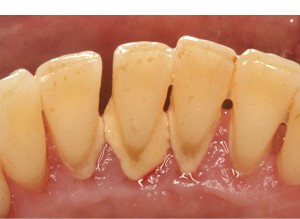Periodontal disease is an infection which causes destruction of the tissues which hold the teeth in place (gum, bone & ligament) and can lead to tooth loss. Periodontal disease is generally a painless condition; therefore you may be unaware of its presence in your mouth.

HEALTHY GUMS
- Pink gums, which do not bleed on brushing.
- Regular dental visits are important to detect periodontal disease early.

GINGIVITIS
- Caused by a buildup of dental plaque because of poor tooth cleaning, especially near the gum margin.
- The gums become red or bleed on brushing.

PERIODONTITIS
- Toxic substances produced by plaque bacteria spread below the gum damaging the supporting bone and fibres that hold your teeth in place.

PERIODONTITIS
- Toxic substances produced by plaque bacteria spread below the gum damaging the supporting bone and fibres that hold your teeth in place.
HOW DO YOU KNOW IF YOU HAVE PERIODONTAL DISEASE
- A bad taste in your mouth and/or bad breath
- Gums that bleed when brushing or flossing
- Red, swollen and/or tender gums
- Longer appearance of teeth
- Receding Gums
- Gum boils or abscesses
- Teeth that seem loose
- Spaces unexpectedly developing between your teeth
PERIODONTAL TREATMENTS
-
Periodontal health should be achieved in the least invasive and most cost-effective manner. This is often accomplished through non-surgical periodontal treatment. Non-surgical periodontal treatment does have its limitations. When it does not achieve periodontal health, surgical intervention may be indicated to restore periodontal health.

SCALING AND ROOT PLANNING
Scaling and root planing is a thorough cleaning of the tooth surface below the gum to remove plaque and calculus [tartar] from deep pockets. This ensures removal of bacterial deposits and a clean smooth root surface. This treatment is carried out with local anesthetic (numbing or freezing) and is entirely painless.
Most gum specialists can achieve excellent results with scaling and root planning alone and many patients do not require any further surgical treatment. However, the majority of patients will require ongoing maintenance therapy (scale and polish) to prevent recurrence of this disease.

PERIODONTAL SURGERY
These are procedures are used to regenerate or correct bone and tissue loss that was caused by periodontal disease.
Your periodontist may recommend a surgical approach if scaling and root planning has not been 100% effective. These procedures can reverse some of the damage by regenerating lost bone and tissue.
During this procedure, your periodontist fold back the gum tissue and removes the disease-causing bacteria. Bone grafts or tissue-stimulating proteins can be used to regenerate bone and tissue.
Eliminating existing bacteria and regenerating bone and tissue helps to reduce pockets and repair damage caused by the progression of periodontal disease. With a combination of daily oral hygiene and professional maintenance care, you can increase the chances of keeping your natural teeth – and decrease the chances of other health problems associated with periodontal disease.

COVERING EXPOSED ROOTS (GUM GRAFTING)
Exposed tooth roots are the result of gum recession. Gum graft surgery will repair the defect and help to prevent additional recession and bone loss.
During gum graft surgery, your periodontist takes gum tissue from your palate or another source to cover the exposed root. This can be done for one tooth or several teeth to balance your gum line and reduce sensitivity.

INCREASING CROWN LENGTH
If you have a “gummy” smile your teeth may actually be the proper lengths, but they’re covered with too much gum tissue. If your teeth appear short you may require a crown lengthening procedure. During the crown lengthening procedure, excess gum and bone tissue is reshaped to expose more of the natural tooth. This can be done to one tooth, to even your gum line, or to several teeth to expose a natural, broad smile.
Your dentist or periodontist may also recommend dental crown lengthening to make a crown or filling possible. Perhaps your tooth is decayed or broken below the gum line, or has insufficient tooth structure for a crown or bridge. Crown lengthening adjusts the gum and bone level to expose more of the tooth so it can be fully restored.
From Luas
The nearest station to us is Charlemont, which is a 5-10 minute walk away.From Dart
The nearest station to us is Grand Canal Dock, which is a 5-10 minute walk away.Via Dublin Bus
25x From UCD Belfield Towards Lucan

